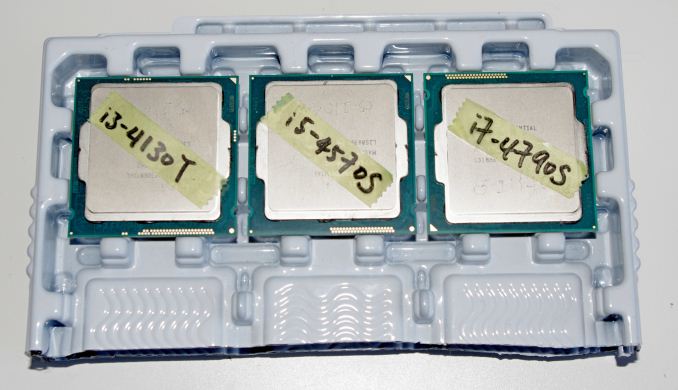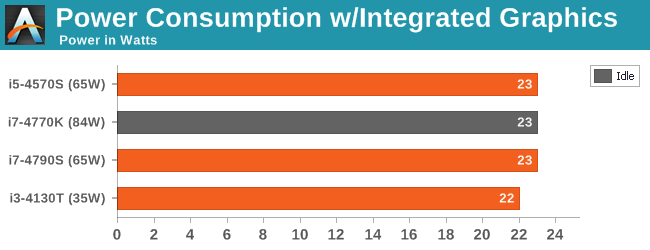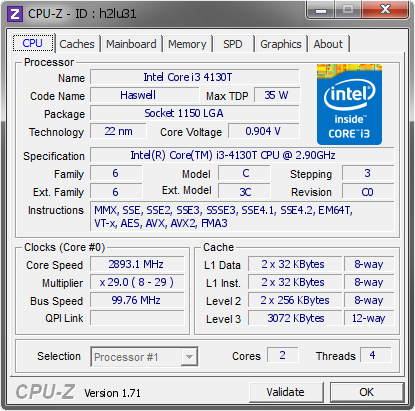Intel Haswell Low Power CPU Review: Core i3-4130T, i5-4570S and i7-4790S Tested
by Ian Cutress on December 11, 2014 10:00 AM EST
Despite being an integral part of Intel's product stack, reviews of the lower power models are few and far between. For those of us that have no interest in overclocking, the lower power parts can offer similar stock performance to the big boys but at 65W and 35W. Today we are testing three chips available from Newegg at $135, $215 and $315.
Not All CPUs are Alike
While Intel's CPU naming scheme is finally starting to make sense to home system builders, their product stack consists mainly of generic numbers in either Celeron, Pentium, i3, i5 or i7 format unless someone sits down and explains the trend to the individual. These models are clearly defined whereby a bigger number tends to mean more frequency. With this general stack of names, there are sometimes models that come with extra letters. Overclockers already know the K and the X models as having their multiplier unlocked for extra potential, but for other CPUs we have T and S destinations. (Xeons also use the letter L, and mobile chips have H/Y/U.)
Simply put, T is used for 35W/45W models and S is for 65W models. The S models tend to have similar single core performance to their normal cousins, but reach 65W by reducing the multicore frequency when the CPU is loaded. The T models reduce both single core and multicore frequency to hit their 35W or 45W, but tend to be a little more esoteric in their position in the stack.
In general there are two ways to reduce the TDP on a CPU. We can either reduce frequency (easy) or reduce voltage (difficult). Reducing the voltage results in more of a change in power consumption, but the best way to tackle this is when Intel performs its binning process.
When a manufacturer creates a wafer of CPUs, these have to be tested for accuracy of calculations, functions, and the voltage/frequency response. It is this latter characteristic which matters most when determining what product in the stack it should be. The units with the highest frequency for the lowest voltage (on a scale) tend to be reserved for the fastest processors or Xeons. Note that it is not only a single data point being tested, but a whole scale from low frequency to high frequency. The unit has to match an entire line to be sufficient for that designation. Where the low power CPUs come in is that they follow a particular line at a potentially lower voltage range than expected.
There have been reports of the regular branding of CPUs being reduced in frequency and matching the stability of the S/T processors. That is entirely possible, as a unit can be a member of many bins at the same time. At the end of the day, when you purchase a lower power processor, you are essentially guaranteed that level of performance and TDP by the processor manufacturer.
The Product Stack
To represent Intel's Haswell line-up, I want single out where the S and T processors stack up against their normal counterparts. Thus is made somewhat difficult by the Haswell refresh earlier this year which caused a frequency bump in most models, but both pre-refresh and post-refresh processors are still up for sale in most markets.
| Intel Haswell T CPUs | ||||||
| Cores / Threads | TDP | L3 | Base Frequency |
Turbo Frequency |
OEM Price | |
| i3-4130T | 2 / 4 | 35W | 3MB | 2900 | $122 | |
| i3-4150T | 2 / 4 | 35W | 3MB | 3000 | $117 | |
| i3-4160T | 2 / 4 | 35W | 3MB | 3100 | $117 | |
| i3-4330T | 2 / 4 | 35W | 4MB | 3000 | $138 | |
| i3-4350T | 2 / 4 | 35W | 4MB | 3100 | $138 | |
| i3-4360T | 2 / 4 | 35W | 4MB | 3200 | $138 | |
| i5-4460T | 4 / 4 | 35W | 6MB | 1900 | 2700 | $182 |
| i5-4570T | 2 / 4 | 35W | 4MB | 2900 | 3600 | $192 |
| i5-4590T | 4 / 4 | 35W | 6MB | 2000 | 3000 | $192 |
| i5-4670T | 4 / 4 | 45W | 6MB | 2300 | 3300 | $213 |
| i5-4690T | 4 / 4 | 45W | 6MB | 2500 | 3500 | $213 |
| i7-4765T | 4 / 8 | 35W | 8MB | 2000 | 3000 | $303 |
| i7-4770T | 4 / 8 | 45W | 8MB | 2500 | 3700 | $303 |
| i7-4785T | 4 / 8 | 35W | 8MB | 2200 | 3200 | $303 |
| i7-4790T | 4 / 8 | 45W | 8MB | 2700 | 3900 | $303 |
| Intel Haswell S CPUs | ||||||
| Cores / Threads | TDP | L3 | Base Frequency |
Turbo Frequency |
OEM Price | |
| i5-4430S | 4 / 4 | 65W | 6MB | 2700 | 3200 | $182 |
| i5-4460S | 4 / 4 | 65W | 6MB | 2900 | 3400 | $182 |
| i5-4570S | 4 / 4 | 65W | 6MB | 2900 | 3600 | $192 |
| i5-4590S | 4 / 4 | 65W | 6MB | 3000 | 3700 | $192 |
| i5-4670S | 4 / 4 | 65W | 6MB | 3100 | 3800 | $213 |
| i5-4690S | 4 / 4 | 65W | 6MB | 3200 | 3900 | $213 |
| i7-4770S | 4 / 8 | 65W | 8MB | 3100 | 3900 | $303 |
| i7-4790S | 4 / 8 | 65W | 8MB | 3200 | 4000 | $303 |
If we do direct comparison with a few of the S processors with their non-S counterparts, we see their main difference is just the multicore frequency to drive the TDP down.
| Intel Haswell S CPU Comparison | ||||||
| Cores / Threads | TDP | L3 | Base Frequency |
Turbo Frequency |
OEM Price | |
| i5-4590S | 4 / 4 | 65W | 6MB | 3000 | 3700 | $192 |
| i5-4590 | 4 / 4 | 84W | 6MB | 3300 | 3700 | $192 |
| i7-4770S | 4 / 8 | 65W | 8MB | 3100 | 3900 | $303 |
| i7-4770 | 4 / 8 | 84W | 8MB | 3400 | 3900 | $303 |
With the T processors, we see a more aggressive trend especially with the i7 range.
| Intel Haswell T CPU Comparison | ||||||
| Cores / Threads | TDP | L3 | Base Frequency |
Turbo Frequency |
OEM Price | |
| i3-4160T | 2 / 4 | 35W | 3MB | 3100 | $117 | |
| i3-4160 | 2 / 4 | 54W | 3MB | 3600 | $117 | |
| i7-4770T | 4 / 8 | 45W | 8MB | 2500 | 3700 | $303 |
| i7-4770 | 4 / 8 | 84W | 8MB | 3400 | 3900 | $303 |
The i7 35W processors have always been a fascination of mine (much like the 65W 12-core Xeon we reviewed earlier in the year). Ultimately these are best for work flow that can use multicore processing but the code has significant memory delays. This reduces the idle time per core and uses less power.
The purpose of this review is to see how these processors compare to those we have already tested. We currently have a good spread of the Haswell range, and all the results can be found in our online benchmark comparison database, Bench.
Test Setup
| Test Setup | |||||
| Processor | |||||
| Intel Core i3-4130T | 35W | 2C/4T | 2.9 GHz | ||
| Intel Core i5-4570S | 65W | 4C/4T | 2.0 GHz / 3.0 GHz | ||
| Intel Core i7-4790S | 65W | 4C/8T | 2.7 GHz / 3.7 GHz | ||
| Motherboards | ASUS Z97 Pro MSI B85M Eco |
||||
| Cooling | Cooler Master Nepton 140XL | ||||
| Power Supply | OCZ 1250W Gold ZX Series | ||||
| Memory | G.Skill RipjawsZ 4x4 GB DDR3-1600 9-11-9 Kit | ||||
| Memory Settings | 1600 9-11-9-27 1T tRFC 240 | ||||
| Video Cards | MSI GTX 770 Lightning 2GB (1150/1202 Boost) | ||||
| Video Drivers | NVIDIA Drivers 337 | ||||
| Hard Drive | OCZ Vertex 3 256GB | ||||
| Optical Drive | LG GH22NS50 | ||||
| Case | Open Test Bed | ||||
| Operating System | Windows 7 64-bit SP1 | ||||
Load Delta Power Consumption
Power consumption was tested on the system while in a single MSI GTX 770 Lightning GPU configuration with a wall meter connected to the OCZ 1250W power supply. This power supply is Gold rated, and as I am in the UK on a 230-240 V supply, leads to ~75% efficiency > 50W, and 90%+ efficiency at 250W, suitable for both idle and multi-GPU loading. This method of power reading allows us to compare the power management of the UEFI and the board to supply components with power under load, and includes typical PSU losses due to efficiency.
We take the power delta difference between idle and load as our tested value, giving an indication of the power increase from the CPU when placed under stress.

Power consumption for our i3 and i5 samples were near on the mark, whereas the i7-4790S scored 102W from idle to AVX. This is more than the i7-4770K, which might come across as a bit alarming.
We also have some full system power draw numbers from the MSI B85M ECO review, while using a Rosewill Silent Night 500W Platinum power supply. These are still in the 5% power used range for the unit, so efficiency is still around 70-80%.

Load Delta Temperature on Intel Stock Cooler
At request from some of our readers on Twitter, we also measured the temperature delta from idle to load on the stock Intel cooler.













76 Comments
View All Comments
Gowan08 - Thursday, December 11, 2014 - link
I am happy to see these CPUs doing so well for the price. I used the i5 S for a whitebox esxi server build and I couldn't be happier. I ended up building 2 as a way to get to VSAN in my home. the low power consumption works when you are planning to leave the server running for long periods of time. Rock solid processor.StrangerGuy - Thursday, December 11, 2014 - link
As somebody with a stock 4790K I have completely no idea just *what* exactly is the point of these new chips. It doesn't save any power over regular Haswells with regular consumer workloads when cores simply idle while sacrificing significant performance for insignificant power savings for heavy CPU loads.Daniel Egger - Thursday, December 11, 2014 - link
That's interesting, the numbers tell exactly the opposite and many people would argue the other way round that the little bit extra in performance for special cases (SLI setups, HPC, ...) is not worth the additional energy use at idle and load and even less the additional noise for the more capable cooling system.Peter Cordes - Friday, March 27, 2015 - link
They all use the same power at idle. The lower TDP processors make it safe to use a weaker fan or put them somewhere with worse airflow, even in the worst case when something does load the CPU for an extended duration.This and the xbitlabs article someone else linked show that the low-power variants behave the same as the regular versions, except for throttling down out of turbo sooner or farther under extended load. They are NOT more energy efficient, either in the CPU or the IGP.
HPC is the use-case where these lower TDP chips are exactly the opposite of what you want, unless you're really constrained by cooling, or your workload is actually constrained by memory latency but your CPUs are ramping up to max speed anyway.
Cerb - Sunday, December 14, 2014 - link
It does indeed save power, and the review shows exactly that. That is in fact the entire point. 84W may be too high for some scenarios, so there is a demand for CPUs with lower TDP. The Lenovo Outlet has several such PCs for sale at this very moment, that aren't much bigger than my unmanaged switch. I doubt an i7-4790K could be quietly cooled in such a small enclosure.bsim500 - Thursday, December 11, 2014 - link
These reviews are getting worse...1. I agree with the others. Please include separate idle & load power consumption. Include delta if you want *in addition* to not instead of.
2. Why on Earth would you attempt to review low-power CPU's on a 1250w PSU? This is a large part of the reason why there's only a 2w apparent difference between a 35w "T" and a 53w regular Pentium / i3 - at sub 5% loads the "+90% efficiency at 20-80% load" curve rapidly falls away to as low as 70%, even 60% on some PSU's. It can also add up to 20w to idle consumption which defeats the whole point of a low powered chip. The 35w "T" chips in particular are often used in slim TDP limited cases like the Akasa Euler (typically fed from an external 80-160w "brick" Pico-PSU / SFX PSU's or at most 360-400w Gold ATX (where a 70-80w load would be within the 20-80% load "90% efficiency sweet spot" of Gold PSU's)).
3. Idle to load delta power consumption (with no actual idle / load figures) is even worse than "delta only temps" and results in totally useless figures up to 20w out of whack for intended market (thin Mini-ITX) when it comes from a <5% load on a 1250w PSU that no-one would use on such chips. Again - PLEASE just show idle & load watts / temps in future.
4. The i3-4130T has been replaced (at same price) by the i3-4160T which is 200Mhz faster.
5. Is the Haswell +0.1v auto-overvolt on AVX Prime power virus load test really suitable for load testing on low-power CPU's which more than likely won't be fully loaded (or running constant load AVX apps)?
wintermute000 - Thursday, December 11, 2014 - link
"Why on Earth would you attempt to review low-power CPU's on a 1250w PSU?"THIS
BrokenCrayons - Friday, December 12, 2014 - link
I can kind of understand the PSU wattage. The same PSU has to be used across a lot of different system configurations ranging from very low demand hardware to extremely powerful, multi-GPU builds otherwise the results across the entire range become incomparable and possibly less valuable to readers. Then again, it has been a frequently mentioned sticky point for readers. Maybe branching out to a couple of PSUs that are of slightly more suitable wattage for their application would be useful. I think a lot of Anandtech readers, while very interested in tech reviews, aren't always looking for the very fastest and most powerful hardware available. The site does a really good job catering to that audience (I think so anyhow since sort of consider myself one of those kinds of readers who wants elegant, practical computing solutions instead of the biggest/fastest at any cost) with the exception of the PSU sizing problem you mentioned and the lack of absolute consumption numbers. But still, go easy on them. They have a lot of work to keep them busy and a lot of feedback to consider that might sometimes get conflicted between reader opinions.MrSpadge - Thursday, December 11, 2014 - link
The moderate binning should not require different CPUs. It would be nice if Intel simply used the already established tool of cTDP to offer users a choice. Run normally during winter and switch to power reduced mode in summer, or when a long video transcode is needed. Provide a simple app or windows switch for this. The Win Vista/7 gadgets would be ideal for this. Oh, and this software could be used on notebooks & tablets too, where it would be far more useful.Winterblade - Thursday, December 11, 2014 - link
This was just what I needed to read to convince myself of buying the Alienware Alpha base model :)